
True Grit is a 1969 American Western film directed by Henry Hathaway, starring John Wayne as U.S. Marshal Rooster Cogburn, Glen Campbell as La Boeuf and Kim Darby as Mattie Ross. It is the first film adaptation of Charles Portis' 1968 novel of the same name. The screenplay was written by Marguerite Roberts. Wayne won an Oscar for his performance in the film and reprised his character for the 1975 sequel Rooster Cogburn.
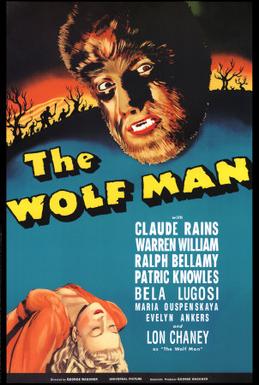
The Wolf Man is a 1941 American gothic horror film written by Curt Siodmak and produced and directed by George Waggner. The film stars Lon Chaney Jr. in the title role. Claude Rains, Warren William, Ralph Bellamy, Patric Knowles, Bela Lugosi, Evelyn Ankers, and Maria Ouspenskaya star in supporting roles. The title character has had a great deal of influence on Hollywood's depictions of the legend of the werewolf. The film is the second Universal Pictures werewolf film, preceded six years earlier by the less commercially successful Werewolf of London (1935). This film is part of the Universal Monsters movies and is of great cinematic acclaim for its production.

Black Sabbath is a 1963 Italian horror anthology film directed by Mario Bava. The film consists of three separate tales that are introduced by Boris Karloff. The order in which the stories are presented varies among the different versions in which the film has been released. In the original, Italian print, the first story, titled "The Telephone", involves Rosy who continually receives threatening telephone calls from an unseen stalker. The second is "The Wurdulak", where a man named Gorca (Karloff) returns to his family after claiming to have slain a Wurdulak, an undead creature who attacks those that it had once loved. The third story, "The Drop of Water", is centered on Helen Corey, a nurse who steals a ring from a corpse that is being prepared for burial and finds herself haunted by the ring's original owner after arriving home.

Bewitched is a 2005 American fantasy romantic comedy film co-written, produced, and directed by Nora Ephron, and starring Nicole Kidman and Will Ferrell alongside an ensemble cast featuring Shirley MacLaine, Michael Caine, Jason Schwartzman, Kristin Chenoweth, Heather Burns, Jim Turner, Stephen Colbert, David Alan Grier, Michael Badalucco, Carole Shelley, and Steve Carell. The film follows an actor (Ferrell) who discovers, during the remake of Bewitched, that his co-star (Kidman) is an actual witch.

Blood and Black Lace is a 1964 giallo film directed by Mario Bava and starring Eva Bartok and Cameron Mitchell. The story concerns the brutal murders of a Roman fashion house's models, committed by a masked killer in a desperate attempt to obtain a scandal-revealing diary.

The Girl Who Knew Too Much is a 1963 Italian giallo film. Directed by Italian filmmaker Mario Bava, the film stars John Saxon as Dr. Marcello Bassi and Letícia Román as Nora Davis. The plot revolves around a young woman named Nora, who travels to Rome and witnesses a murder. The police and Dr. Bassi don't believe her, since a corpse can't be found. Several more murders follow, tied to a decade-long string of killings of victims chosen in alphabetical order.

The Whip and the Body is a 1963 gothic horror film directed by Mario Bava under the alias "John M. Old". The film is about Kurt Menliff who is ostracized by his father for his relationship with a servant girl and her eventual suicide. He later returns to reclaim his title and his former fiancée Nevenka who is now his brother's wife. Menliff is later found murdered, but the locals believe his ghost has returned to haunt the castle for revenge.

Black Sunday is a 1960 Italian gothic horror film directed by Mario Bava in his official directorial debut, and starring Barbara Steele, John Richardson, Andrea Checchi, Ivo Garrani, Arturo Dominici and Enrico Oliveri. Loosely based on Nikolai Gogol's short story "Viy", the film takes place in Moldavia and tells the story of a witch who is put to death by her brother, only to return two centuries later to seek revenge upon his descendants.

Danger: Diabolik is a 1968 action and crime film directed and co-written by Mario Bava, based on the Italian comic series Diabolik by Angela and Luciana Giussani. The film is about a criminal named Diabolik, who plans large-scale heists for his girlfriend Eva Kant. Diabolik is pursued by Inspector Ginko, who blackmails the gangster Ralph Valmont into catching Diabolik for him.

William Berger, also known as Bill Berger and Wilhelm Berger, born Wilhelm Thomas Berger was an American actor, mostly associated with Euro and spaghetti Westerns.

Dolls is a 1987 American horror film directed by Stuart Gordon, written by Ed Naha, and starring Stephen Lee, Guy Rolfe, Hilary Mason, Ian Patrick Williams, and Bunty Bailey. Its plot follows six people who seek shelter during a storm in the mansion of an elderly puppetmaker and his wife, only to find that the various puppets and dolls in the home contain the imprisoned spirits of criminals. It was produced by Charles Band and Brian Yuzna through Band's Empire Pictures.
Antonio Rinaldi was an Italian cinematographer and camera operator. He worked exclusively for director Mario Bava on several films, including Planet of the Vampires (1965), Dr. Goldfoot and the Girl Bombs (1966), and Danger: Diabolik (1968).
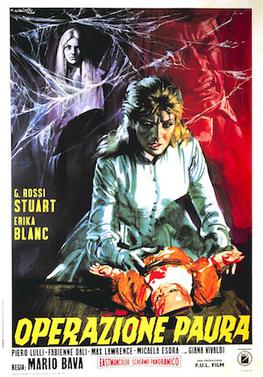
Kill, Baby, Kill is a 1966 Italian gothic horror film directed by Mario Bava and starring Giacomo Rossi Stuart and Erika Blanc. Written by Bava, Romano Migliorini, and Roberto Natale, the film focuses on a small Carpathian village in the early 1900s that is being terrorized by the ghost of a murderous young girl.

Horrible Bosses is a 2011 American black comedy film directed by Seth Gordon, written by Michael Markowitz, John Francis Daley, and Jonathan Goldstein, from a story by Markowitz. It stars Jason Bateman, Charlie Day, and Jason Sudeikis, alongside Jennifer Aniston, Colin Farrell, Kevin Spacey, and Jamie Foxx in their supporting roles. The plot follows three friends, played by Bateman, Day, and Sudeikis, who decide to murder their respective overbearing, abusive bosses, portrayed by Spacey, Aniston, and Farrell.

Macabre is a 1980 Italian horror film directed by Lamberto Bava.
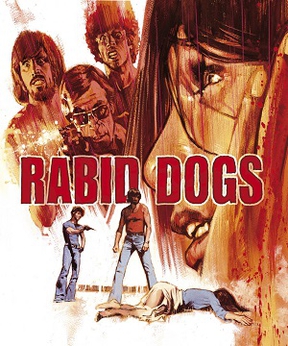
Rabid Dogs is an Italian thriller-noir film directed by Mario Bava, starring Riccardo Cucciolla, Don Backy, Lea Lander, Maurice Poli, George Eastman and Erika Dario. Taking place largely in real time, the film follows a trio of payroll robbers who kidnap a young woman and force a man with a sick child to be their getaway driver, all while trying to avoid being caught by the police.
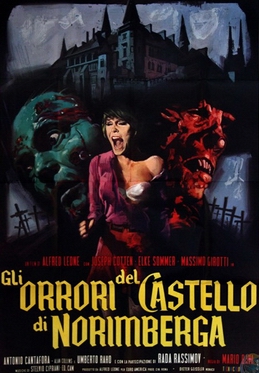
Baron Blood is a 1972 horror film directed by Mario Bava. An international co-production of Italy and West Germany, the film stars Joseph Cotten as Baron Otto Von Kleist, a murderous noble who is resurrected from the dead by his descendant, Peter, and a college student named Eva.

The Young, the Evil and the Savage, also known as Schoolgirl Killer, is a 1968 Italian giallo film directed by Antonio Margheriti.

Roy Colt & Winchester Jack is a 1970 Italian Spaghetti Western film directed by Mario Bava.
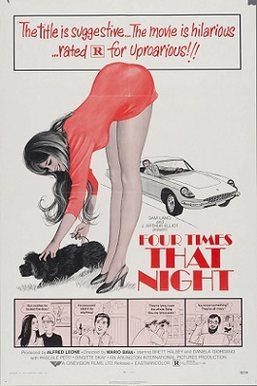
Four Times That Night is a 1971 commedia sexy all'italiana film directed by Mario Bava.



















